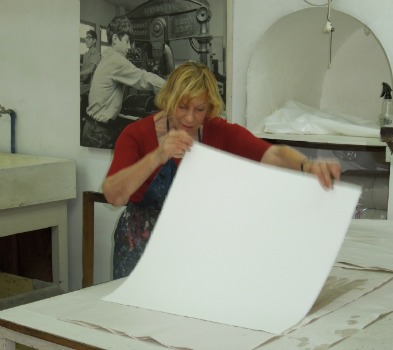“We’ve come here to draw,” declared Prof. Ruth Weisberg, who led a group of artist and architect colleagues on a recent working trip to Israel under the aegis of the University of Southern California’s Dornsife College of Letters, Arts and Sciences. Weisberg, a former dean of USC’s Roski School of Fine Arts, founded and directs the school’s new Initiative for Israeli Arts and Humanities.
An exhibition of works resulting from the trip will be displayed at the USC-Hillel Art Gallery in mid-November through early 2014.
Spread the Word
• Email this article to friends or colleagues
• Share this article on Facebook or Twitter
• Write about and link to this article on your blog
• Local relevancy? Send this article to your local press
“I had traveled with a group of artist friends related to the Roski School in Italy, Norway and China to respond to landscapes and cityscapes through drawing,” the frequent visitor to Israel tells ISRAEL1c. “I wanted to carry on the tradition here. Israel is extremely vibrant intrinsically, and also from my perspective I want people to have positive experiences of Israel. This is a wonderful way to introduce the country to people.”
The May trip was organized and led by Keshet: The Center for Educational Tourism in Israel, which last December put together an art-centered tour of Israel for the Mizel Museum in Denver.
The USC group of seven participants had four days in Tel Aviv and nearly a week in Jerusalem.
Their Jerusalem itinerary included a full day at the Jerusalem Print Workshop; a tour of the Israel Museum and its related Ticho House Museum; a walk through the Machane Yehuda Market, hiking at Sataf park and historical site, and plenty of time to explore and draw the incomparable sights of the Old City’s four quarters.
“I asked Keshet to schedule a three-hour drawing time every day,” says Weisberg, a painter and printmaker.
Most of the participants had been to Israel before. Jan Handtmann of Santa Barbara was one of two exceptions, and she said that at first she felt “like a fish out of water” due to the cultural and language differences.
“But once I got acclimated, I was surprised by the international relations aspects of all these religions in a small area,” she tells ISRAEL21c. “There was more a spirit of working together than I thought there would be.”
‘A kind of wonderment’
Handtmann, a Roski alumna and co-chair of its board of councilors, does multimedia work, printmaking and photography.
“The Old City of Jerusalem was a definite highlight – I found it to be unique visually, intellectually and emotionally. I did a lot of sketches and some under-paintings, and I will construct the artwork in America from some of my photographic images,” she says.
In Tel Aviv-Jaffa, the visiting men and women toured Mira Maylor’s glass studio and the Tel Aviv Museum of Art. They met with Israeli art collector Bill Gross, attended a performance of renowned violinist Itzhak Perlman at the Israel Philharmonic; and spent a day drawing amid the archaeological ruins of Caesarea.
“I’ve been to Israel before with my family, but this is my first time here viewing Israel as an artist and sharing my past experience with our friends who had not been here before. I’m enjoying their reactions,” says Susie Gesundheit of Sherman Oaks, who does water media paintings and monotype printing. “There is kind of a wonderment. I think it’s been enlightening.”
Among her strongest impressions were what she termed the European feel of recent changes in Jerusalem, including the light-rail system, brick walkways and the newly opened cultural hub, The First Station, fashioned from the ruins of an historic train depot.
“Giving old structures new uses, such as the old railway station, makes for a very vibrant experience,” she says.
Her husband Jaime, an architect, says he “really enjoyed the Old City [of Jerusalem] and the pro-preservation movement that is taking hold in Tel Aviv for some of the more significant International [Bauhaus] style buildings of the 1930s and 1940s.”
The group went on a walking and drawing tour of Tel Aviv’s Bauhaus district – the world’s largest collection of International-style architecture.
Fighting for Israel's truth
We cover what makes life in Israel so special — it's people. A non-profit organization, ISRAEL21c's team of journalists are committed to telling stories that humanize Israelis and show their positive impact on our world. You can bring these stories to life by making a donation of $6/month.







